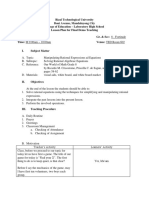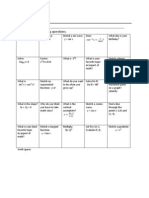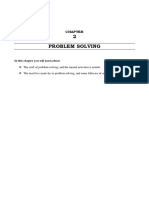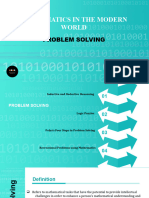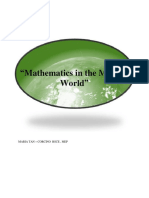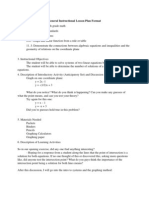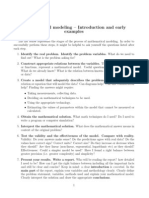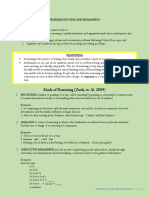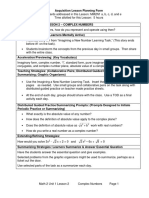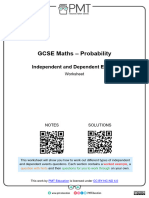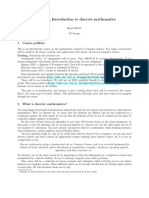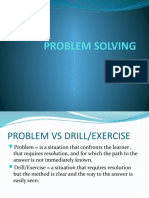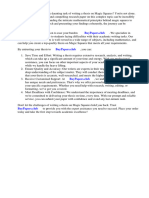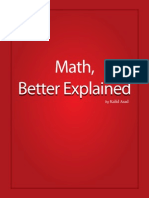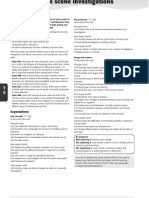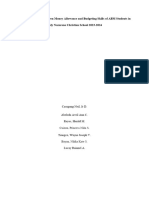0 ratings0% found this document useful (0 votes)
40 viewsDo Something: Problem Solving Strategy Essay # 2
Do Something: Problem Solving Strategy Essay # 2
Uploaded by
RichardRollins1. The document discusses a problem solving strategy for mathematical word problems by breaking them down into steps. It uses an example problem from an AMC competition to illustrate the strategy.
2. The first step is to acknowledge any emotional reactions to the problem and identify its challenging features. The second step is to start exploring the problem without worrying about speed by asking questions, making observations, and trying different approaches.
3. The example problem involves maximizing a quadratic expression given an equation with absolute values. The document walks through exploring the absolute value equation in pieces and attempting to complete the square on the quadratic expression.
Copyright:
© All Rights Reserved
Available Formats
Download as PDF, TXT or read online from Scribd
Do Something: Problem Solving Strategy Essay # 2
Do Something: Problem Solving Strategy Essay # 2
Uploaded by
RichardRollins0 ratings0% found this document useful (0 votes)
40 views7 pages1. The document discusses a problem solving strategy for mathematical word problems by breaking them down into steps. It uses an example problem from an AMC competition to illustrate the strategy.
2. The first step is to acknowledge any emotional reactions to the problem and identify its challenging features. The second step is to start exploring the problem without worrying about speed by asking questions, making observations, and trying different approaches.
3. The example problem involves maximizing a quadratic expression given an equation with absolute values. The document walks through exploring the absolute value equation in pieces and attempting to complete the square on the quadratic expression.
Original Description:
yo
Original Title
essay2
Copyright
© © All Rights Reserved
Available Formats
PDF, TXT or read online from Scribd
Share this document
Did you find this document useful?
Is this content inappropriate?
1. The document discusses a problem solving strategy for mathematical word problems by breaking them down into steps. It uses an example problem from an AMC competition to illustrate the strategy.
2. The first step is to acknowledge any emotional reactions to the problem and identify its challenging features. The second step is to start exploring the problem without worrying about speed by asking questions, making observations, and trying different approaches.
3. The example problem involves maximizing a quadratic expression given an equation with absolute values. The document walks through exploring the absolute value equation in pieces and attempting to complete the square on the quadratic expression.
Copyright:
© All Rights Reserved
Available Formats
Download as PDF, TXT or read online from Scribd
Download as pdf or txt
0 ratings0% found this document useful (0 votes)
40 views7 pagesDo Something: Problem Solving Strategy Essay # 2
Do Something: Problem Solving Strategy Essay # 2
Uploaded by
RichardRollins1. The document discusses a problem solving strategy for mathematical word problems by breaking them down into steps. It uses an example problem from an AMC competition to illustrate the strategy.
2. The first step is to acknowledge any emotional reactions to the problem and identify its challenging features. The second step is to start exploring the problem without worrying about speed by asking questions, making observations, and trying different approaches.
3. The example problem involves maximizing a quadratic expression given an equation with absolute values. The document walks through exploring the absolute value equation in pieces and attempting to complete the square on the quadratic expression.
Copyright:
© All Rights Reserved
Available Formats
Download as PDF, TXT or read online from Scribd
Download as pdf or txt
You are on page 1of 7
1
Problem Solving Strategy Essay # 2:
Do Something
James Tanton, PhD, Mathematics, Princeton 1994; MAA Mathematician in Residence
***
Teachers and schools can benefit from the chance to challenge students with interesting mathematical
questions that are aligned with curriculum standards at all levels of difficulty.
This is the second essay in a series to give credence to this claim on the MAA website, www.maa.org/math-competitions. For
over six decades, AMC has been creating and sharing marvelous stand-alone mathematical tidbits. Take them out of their
competition coverings and see opportunity after opportunity to engage in great conversation with your students. Everyone can
revel in the true creative mathematical experience!
I personally believe that the ultimate goal of the mathematics curriculum is to teach self-reliant thinking, critical questioning
and the confidence to synthesize ideas and to re-evaluate them. Content, of course, is itself important, but content linked to
thinking is the key. Our complex society is demanding of the next generation not only mastery of quantitative skills, but also
the confidence to ask new questions, explore, wonder, flail, innovate and succeed. Welcome to these essays!
Lets make concrete and explicit the benefit obtained from reflecting on, in a deep and joyous way, the mathematical richness
a single AMC problem can offer. There are explicit curriculum connections. There are explicit opportunities for original thinking
and intellectual play. There are opportunities to ask new questions and to explore new mathematical landscapes. There is
human joy in experiencing the true organic and creative nature of mathematics. Do you ever hear those adjectives to describe
math? (ORGANIC MATH? COMPETITON MATH? HUH?)
It is very easy as educators, especially under the pressure of mandated testing, to unknowingly give the impression to students
that all mathematics is geared towards numerical values and answers to what questions: What are the vertex-coordinates of
this parabola? What is the measure of angle A? What is the derivative of
2
sin x ? Yet numerical answers are usually secondary
to the mathematical story at hand.
It is the process of reaching those answers that counts, and this is by far the most interesting aspect. A mathematicianand the
human mind itselfnaturally wonders about why and what if questions. (Alas, such questions are hard to grade and tough
to write for a multiple-choice test! Hmm.)
At first glance, mathematics competitions tend to reinforce the same mis-view of mathematics. The questions asked often
have numerical answers (and so are chiefly what questions) and usually come with a choice of numerical values to consider.
This makes it clear to the student that she is answering questions that have already been answered by someone else, and that
2
she is going to be judged as right or wrong. Moreover, there is little or no time for mullingwhich is deeply unfortunate as
mulling is a fundamental feature in doing true mathematics!
Some students are excited and motivated by the challenge of speed and the sense of competition. Some are not. Some
competitors will recognize and value the joy of the process in answering a competition problem. Some might not.
This letter is not written as a competition training piece. This, like all the letters, is an invitation to find the joy in the whys
and what ifs an interesting mathematical idea can offer. We model how to share that joy with all students.
The AMC has a vast pool of interesting mathematical questions each full of deep and exciting ideas. We show how we can use
them as a springboard for mulling, intellectual exploration, and joyful and mindful mathematics.
Let go of any need for speed.
Revel in the experience of exploration, of feeling flummoxed but pushing on nonetheless.
Work to create a safe culture for your students, one in which they can share and/or explore wild ideas that might
only be false leads. Follow the leads.
Dont just settle for the what answer. Celebrate and mull on tangential ideas, new questions, new connections,
new thoughts.
There really is no hurry. True learning comes from having a sense of ownership of ones mathematics and this takes its own
human time.
****
OUR CHALLENGE TODAY
We contemplate query 18 from the 2011 MAA AMC 12a competition.
Suppose t hat | | | | 2 x y x y + + = . What i s
t he maxi mumval ue of
2 2
6 x x y + ?
How one might go about thinking
about this problem.
STEP ONE: Be honest about your
humanness and acknowl edge your
emot i onal r eact i on i n f i r st r eadi ng
t he pr obl em.
Ill just say it: My first look at this challenge came with an
exclamation of panic!
Li st t he f eat ur es of t he pr obl emt hat
i nduce an emot i onal r eact i on.
I personally find the equation with absolute values scary. I
really dont have any immediate sense of what that
equation is doing/describing/saying.
I am also unsettled by the idea of maximizing a formula
with two variables.
Don t di scount t he psychol ogi cal benef i t
of ar t i cul at i ng your wor r i es. Thei r
pot ency i s di mi ni shed i n doi ng so.
After a breath we might now be ready for
STEP TWO: Do somet hi ng
This is where it is important to let go of the sense of a need
for speed. This is NOT a competition. This is NOT a
mandated test question. This is a human mathematical
experience that is going to take as long as it takes! There
will be false starts, a sense of flailing, and a feeling of being
in the dark. Honor that process. Running this exploration as
a class discussion can dismiss the feeling of any need for
speed and being right right off the bat.
3
It is clear that there are two parts to this problem that
require attention: making sense of | | | | 2 x y x y + + =
and doing something of meaning with
2 2
6 x x y + .
Lets tackle the first equation first. To do something
means to ask
What is the question about?
What do I know about this topic?
Can I do what I know to do in this situation?
The equation | | | | 2 x y x y + + = is about absolute
values. (State the obvious. It helps!) And I know that
absolute values make quantities positive. (Well, I should
say non-negative just in case I am dealing with the
number zero but I dont want to be pedantic right now. I
need to get a line of thought sorted out first.)
We have two quantities x y + and x y that are each
being made positive. And this makes me think of different
cases to examine:
i) x y + and x y are each positive;
ii) they are each negative; and
iii) one is positive, the other is negative. (Or should
I say four cases split this third case into two?)
I really dont know where this is taking me, but I am just
following my nose while keeping my fingers crossed.
The first case: What does it mean for x y + and x y to
each be positive?
Well we have 0 x y + and 0 x y . That is, we have
y x and y x . This is the region in the plane bounded
by two diagonal lines through the origin.
In this region| | | | 2 x y x y + + = reads
2 x y x y + + = , that is, 1 x = . This is a vertical line
segment within that region.
A second case: This time lets consider x y + positive and
x y negative. We have y x and y x , and
| | | | 2 x y x y + + = reads ( ) 2 x y x y + = , that is,
1 y = . We have a horizontal line segment in the region of
the plane in the upper section bounded by the diagonal
lines.
It wont be a surprise now, and one can check, that the
other two cases also yield horizontal and vertical line
segments and we see that | | | | 2 x y x y + + =
describes a square! Wow!
This feels like an accomplishment, but I am not sure what it
does for us.
When st uck, t r y r er eadi ng t he quest i on.
I just did this and I am reminded that there is a second
piece to attend to: maximize
2 2
6 x x y + . What does that
mean?
The formula
2 2
6 x x y + gives different values for
different input points ( ) , x y . We want to find the largest
value that can come out when ( ) , x y satisfies
| | | | 2 x y x y + + = , that is, when ( ) , x y is a point on
the square. Does that help? Not really, but I did reread the
question.
When st uck, j ust do somet hi ng!
What can I do with
2 2
6 x x y + ? What do I know about
things like this?
4
This equation reminds me of quadratics from algebra II.
Maybe I can complete the square:
( )
2 2 2 2
2
2
6 6 9 9
3 9
x x y x x y
x y
+ = + +
= +
Okay. But I dont know what to do next.
When st uck, t r y r er eadi ng t he quest i on.
Maximise
2 2
6 x x y + . Well, that is the same as
maximizing ( )
2
2
3 9 x y + . That is, we need to make
this quantity as large as possible.
Well, I might as well make ( )
2
2
3 x y + as large as
possible and then subtract 9 from its largest output.
Okay What next?
When st uck, j ust do somet hi ng!
Aaaggh! Okay .. What does ( )
2
2
3 x y + remind me of?
The equation of a circle except it is missing the radius
term. (I really do feel like I am struggling for ideas.)
( )
2
2 2
3 x y r + =
This is the equation of a circle centered at ( ) 3,0 with
radius r .
When st uck, t r y r er eadi ng t he quest i on.
We want to maximize ( )
2
2
3 x y + . (Thats my current
version of the question.)
By Jove Its a geometry problem! ( )
2
2
3 x y + is just
my
2
r , and we want to maximize
2
r among all points on
the square. That is, we want a point on the square that
corresponds to a point on the circle, center ( ) 3,0 , of
maximal radius.
That is, we want the point on the square furthest away
from ( ) 3,0 . We see that the points ( 1,1) and ( ) 1, 1
are both the maximal distance from ( ) 3,0 , and by
Pythagorass theorem their distance is
2 2
4 1 17 r = + = . Thus ( )
2
2 2
3 x y r + = has largest
value 17 among all the points on the square, and
2 2
6 x x y + has largest possible value 17 9 8 = . Crazy!
COMMON CORE STANDARDS and
PRACTICES:
Now that we have solved this AMC problem we can see
that it is closely connected with a slew of CCSS-M
standards and curriculum skills:
A-SSE-2: See structure in expressions
A-SSE-3: Write equations in equivalent forms to solve
problems
A-REI-10,11: Represent and solve equations graphically
G-GPE-1: Express geometric properties with equation
We reviewed absolute values and the equation of a circle,
and we completed a square.
We are also right on the mark with the following practice
standards:
MP1: Make sense of problems and persevere in solving
them.
MP2: Reason abstractly and quantitatively.
MP3: Construct viable arguments and critique the
reasoning of others.
MP7: Look for and make use of structure.
5
and maybe even
MP5: Use appropriate tools strategically.
[Have students plot ( )
2
2 2
3 x y r + = for different values
of r and create the diagram on the left themselves and
deduce its meaning.]
DECONSTRUCTING THE PROBLEM:
A great sense of accomplishment comes from solving a
challenge. Good for us! But true progress and innovation in
science and business comes from pushing boundaries,
asking new questions, and forging interesting paths of
ones own devising. Lets help our next generation of
citizens do that too!
How can we use the problem to inspire original enquiry
and discovery?
ASK What was t he bi g i dea behi nd t he
pr obl em? ( The answer i s usual l y hi dden
i n t he par t of t he pr ocess t hat f el t
l i ke a sur pr i se. )
Our solution had an unexpected connection to geometry.
We worked with two curves in the plane a square and a
circle and attempted to find the largest value of some
parameter that altered the one of the curves in our case
the radius of the circle and still had the curves
overlapping.
That is we worked with two curves, each given by a
formula with x s and y s , say ( ) , f x y M = and
( ) , g x y k = , and we wanted to find the biggest value of
M for the points on the curve ( ) , g x y k = .
Curriculum Connection:
LINEAR PROGRAMMING
Some algebra II courses have students play with aspects of
linear programming. Heres a typical textbook question:
Dr. T. is a working mathematician, but he bakes desserts in
his evenings and sells them to the local caf the next day.
He makes pavlova and dacquoise. In an evening he can
bake a maximum of 10 desserts, but at most four of them
can be dacquoise. He makes $2 profit on each pavlova he
bakes and $3 on each dacquoise. How many of each
dessert should he make in an evening so as to maximize his
profit?
Answer: Let P and D represent the quantity of each
dessert. We have the constraints 0 P , 0 D ,
10 P D + and 4 D . These describe a region in the
pavlova/dacquoise plane.
Let M be the profit made. We want to maximize this value
2 3 M P D = + . Now for each value of M ,
2
3 3
M
D P = + is the equation of a line of negative slope.
The placement of this line varies as we change the value of
M .
It is now clear that the largest value of M from the region
we are considering occurs for 4 D = and 6 P = . The
maximum profit is 2 6 3 4 $24 + = - a nice supplement
to his usual income!
6
QUESTION: Is the focus on maximum key? What if Dr. T.
wanted to minimize his profit? What is the obvious
intuitive answer to the minimum problem re how many
desserts he should make? Does the math give the same
answer?
Suppose t hat | | | | 2 x y x y + + = . What i s
t he mi ni mumval ue of
2 2
6 x x y + ?
GIVE POWER TO YOUR STUDENTS:
Have students create their own problems based on the
idea of maximizing or minimizing one formula with a
constraint given by a second formula. They can do it!
OR
Have them see through a whole host of scary looking
questions based on the work they know on the shapes of
graphs. For example: What is the largest a for which the
equations | | y x a = and
2 2
1 x y + = have a common
solution?
Curriculum Connection:
THE REFLECTION PROPERTY OF AN ELLIPSE
Suppose we fix to the two ends of a string at points F and
G on a chalkboard and pull the string taut with a piece of
chalk.
As we swing the chalk about the two points, while keeping
the string taut, we start to trace a curve. One full rotation
produces an oval shape, an ellipse. The special points F
and G are the foci of the ellipse.
Any room with walls curved in the shape of an ellipse has
the astounding property that a whisper uttered at one
focus can be heard by anyone located at the second focus:
sound waves from one focus bounce off the curved wall
and head directly to the second focus. Moreover, the
distance each wave travels is the same, so all arrive
synchronized!
The Mormon Tabernacle in Salt Lake City and the
Whispering Gallery in the United States Capitol building,
Washington, D.C., are each ellipses and so have this
property.
Amazingly This reflection property can be proved
precisely by the method of this letter! It can be a seen as a
minimization problem for two curves in the plane. Watch
the short video www.jamestanton.com?/p=1189 for all the
details!
7
A SECOND SURPRISE:
Continuing to reflect on our solution I recall now that I was
also surprised by the fact that the equation
| | | | 2 x y x y + + = describes a square!
FUN: Sket ch ( ) max | |, | | 1 x y = .
Her e max r epr esent s t he l ar ger of t he
t wo gi ven number s. For exampl e,
( ) max 4,7 7 = and ( ) max 4.6,4.6 4.6 = .
The fact that two very different equations can describe the
same curve reminds me of another curriculum connection:
Curriculum Connection:
THE EQUATION OF A CIRCLE
We teach our students that the equation of a circle with
center ( ) , a b and radius r is ( ) ( )
2 2
2
x a y b r + = .
(This is just Pythagorass theorem at work.)
CHALLENGE:
Let ( )
1 2
, A a a = and ( )
1 2
, B b b = . Show t hat :
( )( ) ( )( )
1 1 2 2
0 x a x b y a y b + = i s t he
equat i on of t he ci r cl e wi t h AB as
di amet er !
Afterthought If this is true, then
( )( ) ( )( ) 2 5 4 9 0 x x y y + = is the equation of the
circle with diameter AB where ( ) 2,4 A = and
( ) 5,9 B = . Or is that with ( ) 2,9 A = and ( ) 5,4 B = ?
Oooh Does this mean something wrong?
What curriculum connections do you notice with this AMC
problem and its solution?
When you discuss this problem and its solution with your
students, what connections do they notice? What new
ideas do they suggest for further exploration?
Mathematics is an ongoing discussion. Textbook questions,
classroom discussions, and competition problems are not
closed, finite experiences. They are invitations for
conversation, exploration and further discovery. Lets keep
open that door of conversation for our students.
Curriculum Inspirations is brought to you by the Mathematical Association of America and the MAA American Mathematics
Competitions.
You might also like
- 2010 - Reynolds & Warfield - Discerning The Differences Between Managers and LeadersDocument5 pages2010 - Reynolds & Warfield - Discerning The Differences Between Managers and LeadersApollo Yap100% (1)
- FINAL COPY Compendium of Notes Grade 8Document44 pagesFINAL COPY Compendium of Notes Grade 8Ma. Nicka Bulatao100% (1)
- Lesson Plan For Manipulating Rational Expressions Ad EquationsDocument9 pagesLesson Plan For Manipulating Rational Expressions Ad Equationslaurice benal100% (1)
- Booklet-Hsc Tips and TricksDocument16 pagesBooklet-Hsc Tips and TricksDavidNo ratings yet
- A Detailed Lesson Plan in Math II ADocument4 pagesA Detailed Lesson Plan in Math II ABrenda OpawNo ratings yet
- Problem Solving PolyaDocument113 pagesProblem Solving PolyaMartin WhiteNo ratings yet
- Math8 Q1 Mod8Document20 pagesMath8 Q1 Mod8Jonnel Dompor CaulawonNo ratings yet
- First Day of Class Task Sheet CalculusDocument2 pagesFirst Day of Class Task Sheet CalculusJessica Tacey MillarNo ratings yet
- How To Think Brilliantly and Creatively in Mathematics: Some Guiding Thoughts For Teachers, Coaches, StudentsDocument39 pagesHow To Think Brilliantly and Creatively in Mathematics: Some Guiding Thoughts For Teachers, Coaches, Studentsknowman1No ratings yet
- What Is Learning and Why Is It ImportantDocument16 pagesWhat Is Learning and Why Is It ImportantAnkit BayerNo ratings yet
- 2 Problem Solving: in This Chapter You Will Learn AboutDocument12 pages2 Problem Solving: in This Chapter You Will Learn AboutAmro EidNo ratings yet
- MMW Chapter 3Document83 pagesMMW Chapter 3Dianarose RioNo ratings yet
- Calculus AssignmentDocument51 pagesCalculus AssignmentPranshuBhatnagarNo ratings yet
- Chapter 3. Problem Solving and Reasoning PDFDocument10 pagesChapter 3. Problem Solving and Reasoning PDFNoel Pelenio BilledoNo ratings yet
- Final Math 3ADocument46 pagesFinal Math 3AClarisse TanglaoNo ratings yet
- Deduce, Don't ReduceDocument4 pagesDeduce, Don't ReduceJames WuNo ratings yet
- HowtoThink JMM2016Document49 pagesHowtoThink JMM2016Muhammad HareesNo ratings yet
- Brazil 2Document47 pagesBrazil 2PiNo ratings yet
- Algebra PortfolioDocument9 pagesAlgebra PortfolioCaryl Franchete0% (1)
- Elementary MathematicsDocument14 pagesElementary MathematicsViet Quoc Hoang100% (1)
- MMW - Module 1Document15 pagesMMW - Module 1Cyril Anne ArroganteNo ratings yet
- Engage in Successful Flailing: Problem Solving Strategy Essay # 1Document6 pagesEngage in Successful Flailing: Problem Solving Strategy Essay # 1RichardRollinsNo ratings yet
- High School Secrets: 1 Translation and Rotation MatterDocument6 pagesHigh School Secrets: 1 Translation and Rotation MatterViet Quoc Hoang100% (2)
- General Instructional Lesson Plan FormatDocument4 pagesGeneral Instructional Lesson Plan Formatmrs_haynesNo ratings yet
- Classical InequalitiesDocument24 pagesClassical InequalitiesThanatkrit KaewtemNo ratings yet
- Classical Inequalities - Ivan MaticDocument24 pagesClassical Inequalities - Ivan MaticrubenvicNo ratings yet
- Ilovepdf Merged PDFDocument78 pagesIlovepdf Merged PDFJoni AboboNo ratings yet
- Lesson On - Problem - SolvingDocument10 pagesLesson On - Problem - Solvingdwaytikitan28No ratings yet
- Under Standing With MethsDocument71 pagesUnder Standing With MethsHaris Ahmed100% (1)
- Calculus Module 2Document10 pagesCalculus Module 2Karl AngcananNo ratings yet
- Independent and Dependent Events SolutionsDocument6 pagesIndependent and Dependent Events SolutionsSabir KhanNo ratings yet
- Mathematics in The Modern WorldDocument17 pagesMathematics in The Modern WorldRanzel SerenioNo ratings yet
- Mathematical Modeling - Introduction and Early ExamplesDocument3 pagesMathematical Modeling - Introduction and Early Examplespromatest2013No ratings yet
- Quarter 2 Module 3 Solving Problems On Polynomial FunctionsDocument16 pagesQuarter 2 Module 3 Solving Problems On Polynomial FunctionsDianne Dynah Bilaro Dy100% (1)
- The Nature of The Solutions To A Quadratic B Ac B X A BXC AxDocument4 pagesThe Nature of The Solutions To A Quadratic B Ac B X A BXC AxSam ShahNo ratings yet
- Problem Solving and ReasoningDocument7 pagesProblem Solving and ReasoningJean MojadoNo ratings yet
- MODULE1 - Mathematics in Our WorldDocument13 pagesMODULE1 - Mathematics in Our Worldsambasares29No ratings yet
- Alberto Añapa Pichota-Foundations of Superior MathematicsDocument310 pagesAlberto Añapa Pichota-Foundations of Superior MathematicsJorge Faustino pineda carbajalNo ratings yet
- Math II Unit 1 Acq Lesson 2 Complex NumbersDocument15 pagesMath II Unit 1 Acq Lesson 2 Complex Numbersdpool2002No ratings yet
- Topic01. Review of Math NotationsDocument17 pagesTopic01. Review of Math Notationsyduoctp.hcmNo ratings yet
- Reasoning-WPS OfficeDocument8 pagesReasoning-WPS OfficeJohary MauyagNo ratings yet
- Math in SecondsDocument19 pagesMath in SecondsAnonymous kPSONENo ratings yet
- Portfolio Sa MathDocument42 pagesPortfolio Sa MathMaria Kristine JazminNo ratings yet
- MMW ReviewerDocument9 pagesMMW ReviewerhirokoanastashiaNo ratings yet
- Building Equations and FunctionsDocument7 pagesBuilding Equations and FunctionsJosué Bolsonaro2018No ratings yet
- G. Independent and Dependent EventsDocument6 pagesG. Independent and Dependent Events2345ghulamNo ratings yet
- Chap 3Document17 pagesChap 3Angel Mie ReyesNo ratings yet
- Problem Solving and Reasoning 1Document42 pagesProblem Solving and Reasoning 1Hola ChinguNo ratings yet
- IG Chapter8Document59 pagesIG Chapter8blue_l1No ratings yet
- 1 IntroDocument12 pages1 Introvijay1080No ratings yet
- Reconstruct Lesson Plan - Polynomials - BinoyaDocument9 pagesReconstruct Lesson Plan - Polynomials - BinoyaRICHARD BINOYANo ratings yet
- Before The Lesson:: S-CP.1: Describe Events As Subsets of A Sample Space (The Set of Outcomes)Document12 pagesBefore The Lesson:: S-CP.1: Describe Events As Subsets of A Sample Space (The Set of Outcomes)Sean SelbaNo ratings yet
- Gr. 5 - Order of OperationsDocument25 pagesGr. 5 - Order of OperationsVhiinXoii BeriosoNo ratings yet
- 3 Problem-Solving SCDocument51 pages3 Problem-Solving SCAnimated StudioNo ratings yet
- MathLesson4 SANTIAGO Amanda G.Document11 pagesMathLesson4 SANTIAGO Amanda G.Amandy SantiagoNo ratings yet
- Magic Squares Research PaperDocument6 pagesMagic Squares Research Paperjtxyihukg100% (1)
- Math Better Explained PDFDocument99 pagesMath Better Explained PDFSanjeev Singh100% (9)
- Attacking Problems in Logarithms and Exponential FunctionsFrom EverandAttacking Problems in Logarithms and Exponential FunctionsRating: 5 out of 5 stars5/5 (1)
- How Pi Can Save Your Life: Using Math to Survive Plane Crashes, Zombie Attacks, Alien Encounters, and Other Improbable Real-World SituationsFrom EverandHow Pi Can Save Your Life: Using Math to Survive Plane Crashes, Zombie Attacks, Alien Encounters, and Other Improbable Real-World SituationsNo ratings yet
- DAILY LESSON LOG OF STEM - PC11SMI-Ij-1 (Week Ten-Day One)Document4 pagesDAILY LESSON LOG OF STEM - PC11SMI-Ij-1 (Week Ten-Day One)Lovely Ann DomasigNo ratings yet
- Book Review of Being A Historian: An Introduction: To The Professional World of HistoryDocument4 pagesBook Review of Being A Historian: An Introduction: To The Professional World of HistoryRoss BosseNo ratings yet
- Perfect Press ReleaseDocument2 pagesPerfect Press Releaseapi-306857114No ratings yet
- Cambridge International General Certificate of Secondary EducationDocument8 pagesCambridge International General Certificate of Secondary EducationPranav PatchaNo ratings yet
- Guidelinefor CentreSuperintendentPrac9.02.2013Document120 pagesGuidelinefor CentreSuperintendentPrac9.02.2013JasmineNo ratings yet
- BEAM LG Gr. 8 Module 6-Mathematics Operations On Rational Algebraic ExpressionsDocument46 pagesBEAM LG Gr. 8 Module 6-Mathematics Operations On Rational Algebraic ExpressionsjeanNo ratings yet
- CV CreativeDocument1 pageCV CreativeAndi Dwi PNo ratings yet
- Immersion I Lesson Plan FormatDocument8 pagesImmersion I Lesson Plan Formatapi-272826545No ratings yet
- DLL - English 4 - Q3 - W7Document6 pagesDLL - English 4 - Q3 - W7zydrickNo ratings yet
- Uts International Ug Course Guide 2023 FormDocument6 pagesUts International Ug Course Guide 2023 FormMohammad HaiderNo ratings yet
- "School Is A Scam" Mantra A Product of Nigerian Education DecadenceDocument13 pages"School Is A Scam" Mantra A Product of Nigerian Education DecadencedanielhalleluyahelijahNo ratings yet
- A Comparison of A Student's Performance During Online and Face-to-Face ClassesDocument4 pagesA Comparison of A Student's Performance During Online and Face-to-Face ClassesVince LabanonNo ratings yet
- America Is in The HeartDocument2 pagesAmerica Is in The HeartJansen UyNo ratings yet
- Foreign StudyDocument4 pagesForeign StudyPether HechanovaNo ratings yet
- Registration Week For Postgraduate Programme, Ips, Upsi: SEMESTER 1, SESSION 2021/2022 (OCTOBER 2021)Document1 pageRegistration Week For Postgraduate Programme, Ips, Upsi: SEMESTER 1, SESSION 2021/2022 (OCTOBER 2021)Raja Muhd AzriNo ratings yet
- KS3 Science Download Your Free KS3 Science Lesson PlanDocument24 pagesKS3 Science Download Your Free KS3 Science Lesson Planravikang2002No ratings yet
- Syllabus Systems Analysis I Spring 2011Document6 pagesSyllabus Systems Analysis I Spring 2011ilikechicken68No ratings yet
- Spring 2014 CalendarDocument1 pageSpring 2014 CalendarjohanabdulaNo ratings yet
- Letter of MotivationDocument2 pagesLetter of MotivationEva MugideNo ratings yet
- PortfolioDocument21 pagesPortfolioAnonymous eWdjt9HNo ratings yet
- The Relationship Between Money Allowance and Budgeting SkillDocument22 pagesThe Relationship Between Money Allowance and Budgeting SkillHerald ReyesNo ratings yet
- Submitted by Scott Thornbury On 27 May, 2009 - 15:06: Methods, Post-Method, and MétodosDocument12 pagesSubmitted by Scott Thornbury On 27 May, 2009 - 15:06: Methods, Post-Method, and MétodosGabriela MarilenaNo ratings yet
- Classroom Observation Assignment-Form 1 BlankDocument4 pagesClassroom Observation Assignment-Form 1 Blankapi-340872807No ratings yet
- Prescription Drug Abuse Crisis in NYS - Comprehensive ApproachDocument26 pagesPrescription Drug Abuse Crisis in NYS - Comprehensive ApproachNew York SenateNo ratings yet
- Different IdiomsDocument7 pagesDifferent IdiomsPeter DindahNo ratings yet
- Socials 20-1 Course OutlineDocument5 pagesSocials 20-1 Course Outlineapi-423503437No ratings yet
- Curriculum and Instruction Thesis TopicsDocument7 pagesCurriculum and Instruction Thesis Topicsvaj0demok1w2100% (2)
- 03 Mech Ug Full 7copiesDocument308 pages03 Mech Ug Full 7copiesEngineerNo ratings yet
- Tender For Aluminium Partition Work 2008Document3 pagesTender For Aluminium Partition Work 2008Alok MehtaNo ratings yet


